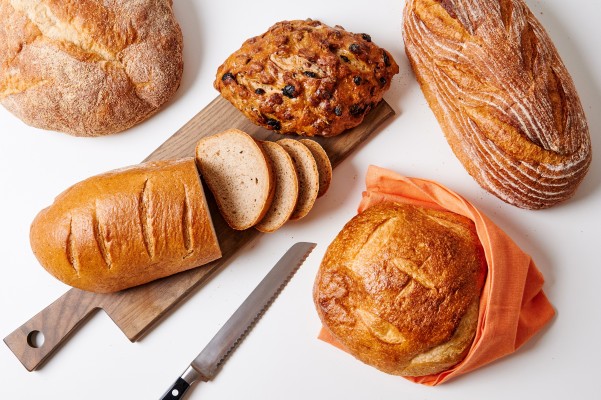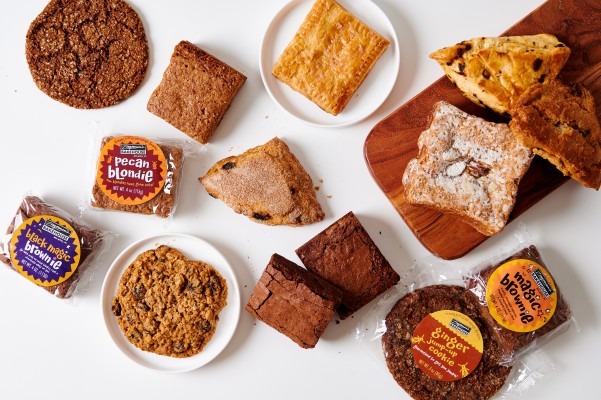
Bread by mail? Really?
We ship thousands of loaves every year to bread lovers nationwide.
Our artisan bread is baked down the road from us at Zingerman’s Bakehouse. We ship bread using two business day service – nothing slower. Our bread doesn’t have any preservatives, so we use expedited shipping to help ensure it arrives in great condition.
The bread will last on the counter for a few days in its Zingerman’s bread bag.
It does not need to be refrigerated – in fact, we recommend you avoid the fridge! Refrigeration will wreak havoc on the texture.
If you want to keep the bread for more than a few days your best bet is to freeze it.
Double bag the loaf—or part of it—in plastic and freeze for up to three months.
All of our full-flavored breads are completely baked all the way so reheating is not necessary.
You can eat the bread right out of the bag (ripping pieces or cutting slices – no judgment here). If it seems a little hard or dry, that’s because the thick, crisp crust is meant to protect the bread. Just like the rind on a natural cheese, real bread has very real crust to protect the inside of the loaf from drying out.
We only suggest that the bread will give you the “just out of the oven” experience… if you reheat it in the oven.
For a warm crackly crust and a soft, chewy crumb, we suggest putting your loaf (whole, half, or part) in a 325 degree oven for approximately 15-20 minutes. If you’re pulling bread out of the freezer, let it defrost for about 30 minutes before throwing it in the oven.

How long will the pastries last?
All of our Zingerman’s Bakehouse pastries and coffee cakes are baked with full-flavored ingredients, but without preservatives. The good news is we’ve done the hard work of tasting and testing to ensure that they can be enjoyed for weeks to come.
If enjoying soon, keep them at room temperature.
Each baked good will have an “eat or freeze by” sticker that is about two weeks from when the package ships out. If enjoying the treats within a week or so of delivery, they can be kept at room temperature in the packaging they arrived in or in a plastic bag. Avoid the refrigerator, it can ruin the texture.
If enjoying later, keep them in the freezer.
For longer term storage, all of our baked goods freeze well for up to three months. They can be stored in the freezer in their original packaging or, if they’ve been opened, double wrapped in plastic bags.
After the freezer, it is best to allow frozen pastries and coffee cakes to defrost slowly at room temperature in the packaging. That’s all–though with some pastries like scones, a little warm up in an oven will make them extra delicious.

Two things that make Zingerman’s Candy taste so good
Zingerman’s Candy Manufactory has been crafting delicious confections for fifteen years with a focus on traditional American candy. Each sweet treat takes days to make, and has remarkably full flavor. Here are two factors that make Zingerman’s candy different than your average grocery store find.
Made by hand, not by machines
Instead of massive industrial cookers mechanically churning out literal tons, we still make our peanut brittle, nougat, and caramel by hand in big pots on a stove.
“Made by hand” might sound like a throwaway marketing line, but it actually does translate to taste. Making caramel in smaller batches means we can caramelize it more for richer, deeper flavors. Those huge commercial vats hold about 50 times more, so they can’t cook as long without burning the caramel on the bottom.
We also hand-pull our peanut brittle, carefully stretching and pulling the melted nut and sugar mixture before it cools. Most companies, even smaller ones, rely only on the little bubbles from baking soda for an airy, crisp texture. But hand-pulling puts bigger air pockets into the mix for an even flakier bite—and it never sticks in your teeth.
Especially flavorful ingredients
We use high quality ingredients for each candy component. Take the peanuts. Instead of the typical small runner peanuts, we source big Virginia Jumbo peanuts for better crunch. Industrial makers will buy roasted nuts to save time, but they quickly lose flavor and texture. By roasting in house, we get the freshest flavor and we control the salt and roast levels. We grind our house-roasted nuts to make our own nut butters instead of pulling a jar off the shelf with added sugar and other filler ingredients. And that’s just the nuts. We use just as much care in selecting our chocolate, our sugar—even our raspberry preserves!
Looking at the ingredient list on a mass-produced candy bar, you’ll notice something we don’t add: preservatives. It’s cheaper to add preservatives because companies can make more candy at one time and hold onto it for longer. Think about a regular candy bar in the grocery aisle. Do you have any idea when it was made or how long it’s been sitting there?
With ours, you do. It’s likely no more than a few weeks old when you receive it. You’ll want to eat it within a couple of months for best texture and flavor. You really can taste the difference.

How to store and serve cheese
How should the cheese be stored?
Hard cheeses have been carefully selected to withstand a longer transit time. Don’t worry if it arrives a bit warm or a bit cold – cheese is durable. Hard, aged cheeses stay good for a long time. Many days for sure. Sometimes weeks. Bigger hunks of cheese last longer. If it looks and smelled as expected, it’s likely still great.
Soft cheeses and cheese spreads (like pimento and liptauer) are best eaten within a week or two of receiving them.
We wrap hand-cut wedges of cheese in a cheese bag before shipment, and you can continue to keep the cheese in that cheese bag. The next best option would be parchment or wax paper. After you open the cheese for a nibble, any remainders can be put back into the bag and closed with a simple roll or fold.
Store cheese in the fridge, ideally in the spot closest to 50 degrees. That will likely be the door of your refrigerator or in a drawer where the temperature is consistent but not too cold. Do not freeze your cheese! Cheese is a living thing. Freezing will stop the natural processes that keep cheese so tasty.
What if it’s got a little mold on it? A little mold is no problem. It’s a good sign, it means the cheese is alive. Scrape it off with a knife. But if there’s a lot of mold and it’s turning dark and funky it’s time to say goodbye.
What’s the best way to serve cheese?
Regardless of the kind of cheese, it’s best to take it out of the fridge about 20 to 30 minutes before serving it. Cheese tastes better at room temperature. It makes a world of difference: the aromas expand, becoming more complex; more of the fat spreads on your tongue, which makes the flavor more intense. When cheese is warm you’ll eat less of it and enjoy it more.